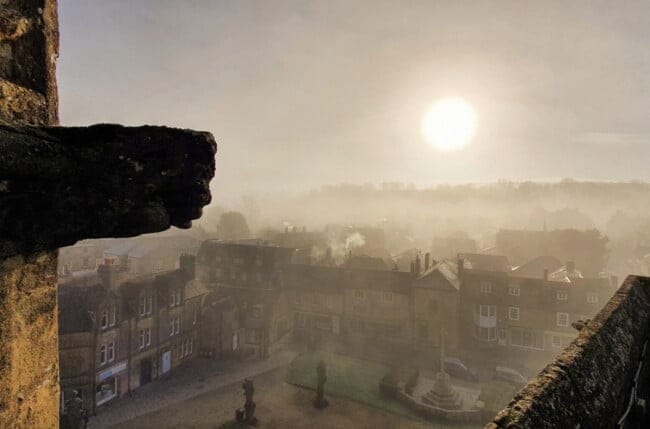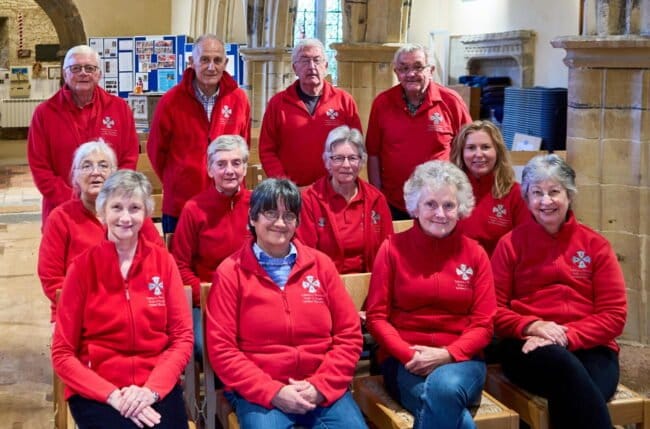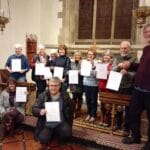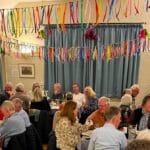For this Guild Newsletter, a double-feature for the Tower of the Month segment: the towers of Cranborne and Wimborne St Giles, both in the East Dorset Branch. The towers share a combined ministry and band, as well as being notable for being the shortest distance between two true-harmonic rings in the Diocese.
Wimborne St Giles
Wimborne St Giles, named after the nearby town of Wimborne Minster and the village church dedicated to Saint Giles, is famous for being the seat of the Earl of Shaftesbury since 1622. Whilst the influence of the Earls can be seen almost everywhere in the present church, the foundation of the parish predates the foundation of the seat by some four centuries, and that of the village many centuries before that. Though the village is named in the Domesday Book, with its land being owned by a combination of the Abbeys of Cranborne and Wilton, a church is not mentioned.
The earliest reference to the church is when a rector was installed in 1207, though the church building itself was not mentioned until 1291. This medieval parish church, most likely a small building owned by Cranborne Abbey, survived until the third decade of the 17th century when it was pulled down and rebuilt under patronage from the 1st Earl of Shaftesbury, Sir Anthony Ashley. Ashley died in 1628 and was buried in a spectacular tomb in the church, which still survives today.
The church was rebuilt again just over 100 years later by the unfortunately-named Bastard brothers. John and William Bastard were, and still are, best known for rebuilding almost the entire town of Blandford Forum in 1731 following a catastrophic fire, before turning their attention to Wimborne St Giles in 1732. The new church was designed and built in the Georgian style, and the similarities between the new churches at Blandford and Wimborne St Giles can be easily spotted, even by an untrained eye.
Externally, the church at Wimborne St Giles is almost identical to how it was built in 1732, but the interior tells a different story. The interior has been remodelled and rebuilt three times since 1732, firstly in 1852 by another Earl of Shaftesbury, and more substantially in 1887 by Victorian architect George Frederick Bodley, under subscription from the 9th Earl. Bodley was primarily a Gothic Revival architect, and the interior was remodelled to suit his tastes, that is to say, the insertion of Gothic pointed arches to split the nave into three sections. During this work in 1887, a robin nested on one of the newly constructed arcades, and it was decided to preserve this nest in a glass bottle, grouted into the wall.

On 30th September 1908, the church caught fire when soldering work on the roof went wrong. The fire spread quickly and led to the near-complete internal ruin of the building, including the bells, organ and fittings. One notable survivor, however, owing to it being grouted into the wall, was the robin’s nest. Sir Ninian Comper, a pupil of Bodley, was engaged by yet another of the Earls, to rebuild the church.
Comper rebuilt the church from 1908 to 1910, utilising the surviving 18th-century walls and thus keeping its external appearance similar to before the fire. Inside, however, he extended the church northwards with a new north aisle and added a lady chapel. He designed all new stained glass windows, incorporating fragments of the glass that survived the fire and added a new intricate wooden screen to separate the nave and chancel. He also replaced and redesigned the roof, designed numerous new sculptures and added a western gallery to the nave.
Comper’s work, considered to be one of his best, is designed in the richest Gothic Revival style; most first-time visitors to the church are quite shocked by its opulent interior compared to the austere exterior. The church is almost exactly how Comper left it, and provides a good contrast to Blandford’s parish church, which is almost exactly how the Bastard brothers left it, and thus shows what the interior at Wimborne St Giles may have originally looked like.

Bells
The earliest record of bells at Wimborne St Giles is in a 1552 inventory, where three bells are recorded. There were also three bells recorded in the same inventory at Wimborne All Saints (part of the Cranborne hundred). In 1656, a small bell was cast by William Purdue III and Nathaniel Parker of Salisbury and added to the church tower as a service bell. It weighed approximately three-quarters of a hundredweight (38 kg).
In 1732, the parishes of both churches were joined, and so the three bells from All Saints were put towards the recasting of the bells at St Giles. A clock bell was cast by William Toiser of Salisbury in 1732 and hung on the tower roof. This bell weighed approximately one and a half hundredweight (75 kg). Apart from these two small bells, the three bells from St Giles and the three from All Saints were broken up and recast into a ring of six bells in 1737 by Abel Rudhall of Gloucester. The heaviest bell, the tenor, weighed approximately 9 hundredweight.
All of these bells, including the two smaller ones, were destroyed in the blaze of 1908, when the fire consumed the timber bell frame and the floors in the tower, causing the bells to fall to the ground. From their casting in 1737 until their destruction in 1908, they were the only example in Dorset of Rudhall bells. Dorset gained a further set of Rudhall bells in 1974 when the county border changes brought Christchurch Priory into Dorset, which contains four Rudhall bells within its ring of twelve.
As the restoration of the tower neared completion in 1909, Comper was concerned with the ability of the fire-weakened walls to support a ring of bells again. He proposed one large bell, however, the tower proved quite capable of housing more, so in 1910, a ring of six bells was cast and installed by John Taylor & Co of Loughborough. These six bells were hung in a new cast iron frame dug into the tower walls. They were heavier than their predecessors, the tenor bell weighing 12 cwt 1 qr 12 lb (628 kg) and striking the note G. The new bells were dedicated on 10 September 1910; St Giles’ Day.
In 1928, these bells were augmented to eight by Taylor’s, rather more unusually by adding a treble and tenor. The fourth bell was retuned down a semitone to Bb to become the fifth, with the new treble and tenor bells striking the note F. The previous six bells were thus renumbered to become bells two to seven. The tenor bell now weighs 14 cwt 1 qr 5 lb (726 kg). The 1910 metal frame was extended to fit in the extra two bells.

In 2014, the sixth bell cracked as a result of an accident and was recast by Taylor’s in 2015 to the same dimensions as the original. The newly recast bell, which reused the fittings from 1910, was inspected by the then Prime Minister David Cameron at Taylor’s foundry in Loughborough during his tour of the works, before being rehung at the church. Further work was undertaken at the end of 2023, to rehang the 5th and 7th onto ball bearings, again by Taylor’s.
Cranborne
Unlike Wimborne St Giles, Cranborne was a monastic institution for much of its life; one of the most influential in the county. The early history of Cranborne’s monastery is difficult to pin down with certainty, but one of the more reliable sources comes from the Chronicle of Tewkesbury, written in the early 13th century. The Chronicle states that in 930, during the reign of Athelstan, there was a knight named Aylward Sneaw (also known as Aethelweard Maew), nicknamed ‘Snow’ for his pale complexion. Aylward founded an abbey at Cranborne, dedicated to the Virgin Mary, no later than 980. Aylward was the patron of the monastery at Tewkesbury, which he made subservient to his new monastery at Cranborne, thus making Tewkesbury a priory.
Following the Norman Conquest of 1066, the holder of the manor, Brihtric, was imprisoned by William the Conqueror in Winchester Castle for an act of disrespect against his wife, Queen Matilda. His estate, including the monastery at Cranborne, was confiscated, and granted to Robert Fitzhamon, a Norman nobleman. The Domesday Book of 1086 records that Cranborne Abbey was one of the most important monastic foundations in the region, holding at its maximum extent some 13,000 acres of land across four counties, including in Gillingham (Dorset), Damerham (Hampshire), Ashton Keynes (Wiltshire) and Loosebeare, near Crediton (Devon).

By 1102, Fitzhamon had become lord of Tewkesbury, and the monastery there was in ruins. When Fitzhamon and the abbot of Cranborne, Giraldus, worked to rebuild the monastery there, they realised that Tewkesbury was much better sited, offering strategic importance due to its location at the confluence of two rivers, the Severn and the Avon, as well as more fertile land and better access to water, compared to Cranborne’s small River Crane. As such, the situation of 980 was reversed, Cranborne now becoming entirely subservient to Tewkesbury. Subsequently, Giraldus, now abbot of Tewkesbury, accompanied by fifty-seven monks, left Cranborne for Tewkesbury Abbey, where it was gradually rebuilt into the massive church that still dominates the plains of the Severn today.
Cranborne, now a priory, was rebuilt from 1120 to 1252 in the Early English Gothic style when it was reconsecrated. The nave and tower were heightened in the 15th century, which was the final major building work before it was surrendered to the crown in 1540 as part of the Dissolution of the Monasteries.
Much of the priory church survives as the parish church of Cranborne, dedicated to St Mary and St Bartholomew, though the chancel and east end were rebuilt in the 19th century. The oldest part of the building is the Norman doorway in the porch, which dates back to 1120, and features recessed arches and dog-tooth carvings. 12th-century fragments also survive in the lower parts of the south aisle wall, and the nave piers. For a relatively small village, the church is large and spacious, displaying every style of architecture from the late Norman period to the more decorative Perpendicular Gothic era.
The church has an impressive exterior, dominated by the substantial west tower, which rises some 75 feet (23 m) from ground level, making it amongst the largest in any village church in Dorset. The tower was built in 1440 at the expense of Richard, Duke of York, in the Perpendicular Gothic style, and presumably contained bells from the outset.
The first record of bells at Cranborne was in an inventory in 1552, where four bells were recorded. Some of these bells were recast several times in the following centuries, firstly by John Wallis of Salisbury in 1608 and 1610, then again by Clement Toiser in 1713.
Thomas Mears II of the Whitechapel Bell Foundry remodelled these bells into a ring of six in 1841 by melting down the 16 long cwt (813 kg) tenor and using the metal to cast two new trebles, recasting the third and fourth at the same time. Following the 1841 remodelling, only one bell remained from those recorded in 1552, the third, cast by the Salisbury Foundry in c. 1525. The other bell not recast by Mears was the bell recast by Toiser in 1713, which became the tenor of the ring of six from 1841 onwards. Mears also rehung all six bells with new fittings in the existing timber frame and provided a new ringing chamber floor, the bells likely being rung from the ground floor before this date. The total cost of this work was £224 11s 6d. The Toiser bell was weighed at this time and found to be 13 cwt 3 qr 24 lb.
By the late 19th century, the frame was in dangerous condition, and ringing was suspended for fear of damage to the tower. A meeting of the parish council was called in 1889, and it was decided that the frame and belfry floor should be replaced, and if enough money could be raised, the bells augmented to eight with two new trebles, given the ample space in the tower. John Warner & Sons of Cripplegate, London, won the contract, and work commenced in 1890. The bells were all rehung by Warners in the new frame, with new fittings including wooden headstocks and plain bearings. The new frame was designed for eight bells and manufactured of timber. The first full peal on the bells and in the tower was on 6 June 1892, comprising 5040 changes of Grandsire Triples in 3 hours and 1 minute, rung by the Winchester Diocesan Guild of Ringers.

In the very late 19th century, John Taylor & Co. of Loughborough mastered the art of true harmonic tuning, a technique thought to be lost. As such, by 1948, it was realised that Cranborne’s bells, cast before this technique was mastered, were tonally poor, so a scheme was launched to replace the mixed ring of eight with a new and heavier eight which would be more in tune with each other. The contract was awarded to John Taylor & Co. in 1950, who removed the old bells from the tower in the final months of 1950. The fifth bell of the ring of eight was the 1525 bell mentioned in the inventory in 1552, and it was poorly toned, but considered too historic to recast, and was therefore spared. The other seven bells were recast, together with a new bell to replace the aforementioned 1525 bell, on 18 January 1951 at Taylor’s premises in Freehold Street, Loughborough.
All eight bells had new fittings provided, including cast iron headstocks, ball bearings and wrought-iron clappers. The 1525 bell was retired and kept as a service bell; a new frame extension was made by Taylor’s to hang the bell for chiming alongside the newly-recast change ringing bells. The tower thus contains nine bells, eight modern change ringing bells from 1951, and a service bell from 1525. The service bell retains the fittings Warners gave it in 1890, and can now only be sounded using an external hammer. The new tenor bell was heavier than the Toiser bell from 1713, weighing 17 long cwt and 21 lbs, sounding the note of F major. The new ring of eight was dedicated on 17 March 1951 by Lancelot Addison, Archdeacon of Dorset. The total cost of the project was £1,526.
Other than the replacement of the rope rollers (pulleys) and overhaul of clappers in recent years, the bells have had very little attention since their installation, and along with Wimborne St Giles, form a pair of fine-toned, easy going, musical eights.
Jack Pease









